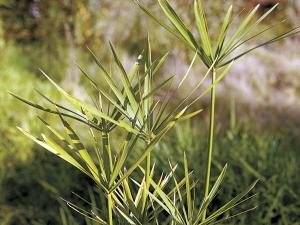Papyrus a dramatic accent around pond, patio
Gardening by the book has its merits, especially if you actually grow your own books. Books in ancient times were simply rolls of papyrus. Indeed, the Greek word for papyrus was biblos or byblos, which became our word “Bible.” Now you can bring an exotic look to your summer garden or potted container with potted papyrus (Cyperus papyrus). Yes, the same papyrus that Egyptians used for writing thousands of years ago. Scrabble players and wordsmiths should know that the proper plural is papyri. Even our word for paper ultimately comes from papyrus. Ancient Egyptians even used papyrus to make mattresses, mats, sandals, rope, baskets, and boats.
Papyrus is often called “umbrella plant” because it sends out sprays of foliage at the top of the stems. These sprays spread out just like the spokes in an umbrella. The triangular stems are stiff with a white pith inside. It is this inner pith that is made into papyrus paper.
Even though papyrus is traditionally grown with its roots in water, it will do just as well in a pot with normal watering. If you do put your papyrus in standing water, keep the rim of the pot no more than six inches below water.
Papyrus is a rapid growing plant, so even tiny plants can reach reach five feet or more in a single year. They do need full sun or they can get spindly.
While papyrus is only hardy in the warmest areas, USDA climate zone 10 and higher for outdoors, it will do quite well in a large pot. Keep it where the temperature is above 50 degrees F.
Papyrus is virtually carefree. You don’t need to prune except to remove dead or broken stems.
Apply a good general purpose organic fertilizer in the spring.
While there are few pests or diseases that attack papyrus you may occasionally find rust fungus that can discolor the stems and leaves.
You can propagate your papyrus plant by dividing it in early spring. After all danger of frost has passed take the plant out of its pot and cut the rhizomes into groups of two or three. Pot up these rhizomes and grow them out as usual. They will quickly root and sprout into new plants.
When temperatures begin to fall you can move your papyrus plants into the house. You can get papyrus plants from local nurseries or by mail from specialty nurseries such as Logee’s Greenhouses, 141 North Street, Danielson, CT 06239, toll-free: 8880-330-8038, or www.logees.com; or Territorial Seeds, 800-626-0866 or www.territorialseed.com.
Papyrus grows so fast that many gardeners use them as annuals around a pond or pool or as a dramatic accent on a patio. There is even a dwarf papyrus (Cyperus isocladus) that only grows 18 inches tall, so you can put an Egyptian theme almost anywhere.
Whether you grow papyrus as an outdoor accent or bring it indoors for the winter, you will add a dramatic touch to your landscape. You might even try mixing your own ancient Egyptian ink out of ocher, gelatin, gum and bee wax. With your own papyrus, you will truly have written the “byblos” or book on gardening.






















































